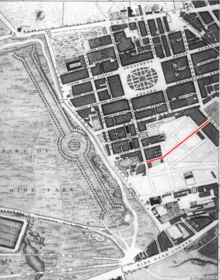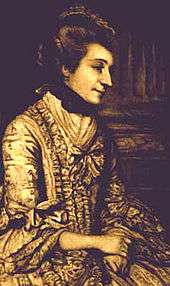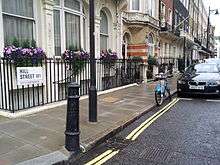Hill Street, London
.jpg)
Hill Street is a street in the central Mayfair district of London which runs southwest from Berkeley Square towards Park Lane. It was developed from farmland in the 18th century[3] and was named after a small hill there. It became a fashionable street in the 18th century and was home to a number of lords. The street contains several Grade I and Grade II listed buildings.
Development and architecture

The street was developed in the 1740s by John Berkeley, 5th Baron Berkeley of Stratton. When John Rocque mapped London in 1746, the development was in progress and so the streets on that side of Berkeley Square were shown only in outline. The area had previously been farmland, and Hill Street crosses Farm Street. Hill Street was named after a rise in the ground, with Hay Hill being another street nearby.[4]
Architects included Benjamin Timbrell, who designed numbers 17 and 19, now both Grade I listed buildings, c. 1748,[5] and Oliver Hill, who worked on number 15 in the 1920s.[6] Numbers 1 and 3 form a Grade II listed building;[7] other listed houses in the street include numbers 11,[8] 31[9] and 36.[10]
Claud Phillimore refurbished number 35 for Lady Astor in the late 1940s. This had six storeys and a basement to provide both a grand and comfortable residence. Lady Astor's personal living room – "the Boudoir" – had walls decorated with blue satin.[11]
Literary associations
Before the palace in Portman Square was built she had lived in Hill Street, Mayfair, her rooms in which are thus depicted by the last-named writer the date being 1773, when Mrs. Montagu was fifty-seven. "If I had paper and time I could entertain you with the account of Mrs. M.'s Room of Cupidons, which was opened with an assembly for all the foreigners, the literati, and the macaronis of the present age. Many and sly are the observations. How such a genius, at her age, and so circumstanced (Mr. M. had recently taken his upward flight), could think of painting the walls of her dressing-room with bowers of roses and jessamines entirely inhabited by little cupids in all their little wanton ways, is astonishing."
Doctor Johnson and the Fair Sex: A Study of Contrasts, W. H. Craig, 1895

Mrs. Montagu hosted a literary salon at her new house in Hill Street. Her circle was known as the Blue Stockings Society and Doctor Johnson called her the "Queen of the Blues".[12] Other luminaries who attended her gatherings included Edmund Burke, David Garrick, Joshua Reynolds and Horace Walpole.[12]
In Jane Austen's novel Mansfield Park, Henry and Mary Crawford's uncle is an admiral living in Hill Street.[13] Sir Walter Scott's novel Waverley was published at the same time. In this, the hero's father is a Whig politician who lives in Hill Street.[14]
Thackeray's Vanity Fair has Great Gaunt Street off Gaunt Square as the home of Lady Gaunt's mother. This fictional street was based upon Hill Street.[15]
Evelyn Waugh satirised Mayfair decadence in his novel Vile Bodies. In this, Hill Street was the location of the fictional Pastmaster House – "the William and Mary mansion of Lord and Lady Metroland with a magnificent ballroom, 'by universal consent the most beautiful building between Bond Street and Park Lane'".[16]
The bright young thing society novelist Nancy Mitford stayed at number 40 in 1955.[17]
Fashionable street

The new housing was fashionable in the 18th and 19th centuries, and notable residents of Hill Street have included:
- Lord Barrymore at number 20[20]
- Lord Brougham at number 5[20]
- Admiral Byng in 1756;[20][21] in 1757 he was sentenced to death and shot for losing Minorca in the Seven Years' War.[22]
- Lord Chief Justice Camden died here in 1794.[20][21]
- Lord Morpeth, 7th Earl of Carlisle was born here in 1802.[20][21]
- Lord Colborne lived at number 19 where he collected paintings.[21]
- Countess of Darnley at number 21[20]
- Admiral Philip Durham at number 9[20]
- Master of the Rolls, Sir William Grant lived at number 21.[21]
- Lord Hindlip at number 33[20]
- Sir Abraham Hume, 1st Baronet and his son the 2nd Baronet lived at numbers 17, 19 and 29.[5][21]
- Lord Londesborough[20]
- Chancellor of the Exchequer, Lord Lyttelton and his wicked son Thomas.[20][21]
- The Mackintosh of Mackintosh at number 8[20]
- Earl of Malmesbury died at number 21 in 1820.[20][21]
- Philip Metcalfe, distiller and patron of the arts, lived at number 20.[21]
- Mrs. Montagu held literary parties here.[3][20][21]
- Lord Revelstoke at number 26[20]
- Countess of Roden at number 27[20]
- Sir Evelyn Ruggles-Brise at number 41[20]
- Lord de Tabley collected and exhibited paintings and sculptures of the English school at number 24.[21]
- Marquess of Tweeddale at number 6[20]
- Lady Vane, the adulteress whose memoirs appeared in The Adventures of Peregrine Pickle, died here in 1788.[20][21]
- Sir Charles Welby at number 34[20]
- Whig politician William Windham lived at number 20.[21]
- Lord Westbury at number 30[20]
- Garnet Wolseley, 1st Viscount Wolseley, field marshal, at number 6[23]
References
- ↑ Coach & Horses, London, Shepherd Neame
- ↑ Coach and Horses public house (1357097), English Heritage, 1 December 1987
- 1 2 Jerry White (2013), A Great and Monstrous Thing: London in the eighteenth century, Harvard University Press, pp. 31,107, ISBN 9780674076402
- ↑ Edward Walford (1878), "Berkeley Square and its neighbourhood", Old and New London, Vol. 4, pp. 326–338
- 1 2 "19, Hill Street W1, Westminster". British Listed Buildings. Retrieved 10 October 2013.
- ↑ Oliver Bradbury (2008), The Lost Mansions of Mayfair, p. 26, ISBN 9781905286232
- ↑ "1 and 3, Hill Street W1, Westminster". British Listed Buildings. Retrieved 11 October 2013.
- ↑ "11, Hill Street W1, London". Go Historic. Retrieved 11 October 2013.
- ↑ "31, Hill Street W1, Westminster". British Listed Buildings. Retrieved 11 October 2013.
- ↑ "36, Hill Street W1, Westminster". British Listed Buildings. Retrieved 11 October 2013.
- ↑ Adrian Fort (2012), Nancy: The Story of Lady Astor, Random House, p. 316, ISBN 9780224090162
- 1 2 "Elizabeth Montagu", The Cambridge Guide to Literature in English, Cambridge University Press, 2006, p. 760, ISBN 9780521831796
- ↑ Nikolaus Pevsner (1968), "The Architectural Setting of Jane Austen's Novels", Journal of the Warburg and Courtauld Institutes, Vol. 31: 404–422, doi:10.2307/750649, JSTOR 750649
- ↑ John Wiltshire (2003), "Exploring Mansfield Park: In the footsteps of Fanny Price" (PDF), Persuasions (28): 86
- ↑ George Hamilton Cunningham (1927), "Hill Street, Berkeley Square", London: Being a Comprehensive Survey of the History, Tradition & Historical Associations of Buildings & Monuments, Arranged Under Streets in Alphabetical Order, J. M. Dent & Sons Limited, p. 348
- ↑ Roger Wilkes (29 May 2002), "Sly smile at the vile", Daily Telegraph
- ↑ Mosley, Charlotte (2012). The Mitfords: Letters between Six Sisters. HarperCollins. p. 290.
- ↑ Two bollards at North East and South East corners of junction with Chesterfield Hill, Hill Street W1 Mayfair (1066632), English Heritage, 1 December 1987
- ↑ 2 bollards at South East and South West corners of Hill Street intersection with South Audley Street W1 (1264577), English Heritage, 1 December 1987
- 1 2 3 4 5 6 7 8 9 10 11 12 13 14 15 16 17 18 19 20 Geraldine Edith Mitton, Mayfair, Belgravia, and Bayswater, ISBN 9781465532039
- 1 2 3 4 5 6 7 8 9 10 11 12 13 Henry Benjamin Wheatley (2011), "Hill Street", London Past and Present: Its History, Associations, and Traditions, Vol. 2, Cambridge University Press, p. 215, ISBN 9781108028073
- ↑ Tute, Warren (1983). The True Glory, The Story of the Royal Navy over a thousand years. Macdonald & Co. pp. 81–83. ISBN 0-356-10403-6.
- ↑ "Garnet Wolseley (1833-1913) Autograph Letter Signed". Owen and Barlow. Retrieved 21 July 2014.
Coordinates: 51°30′31″N 0°8′58″W / 51.50861°N 0.14944°W
